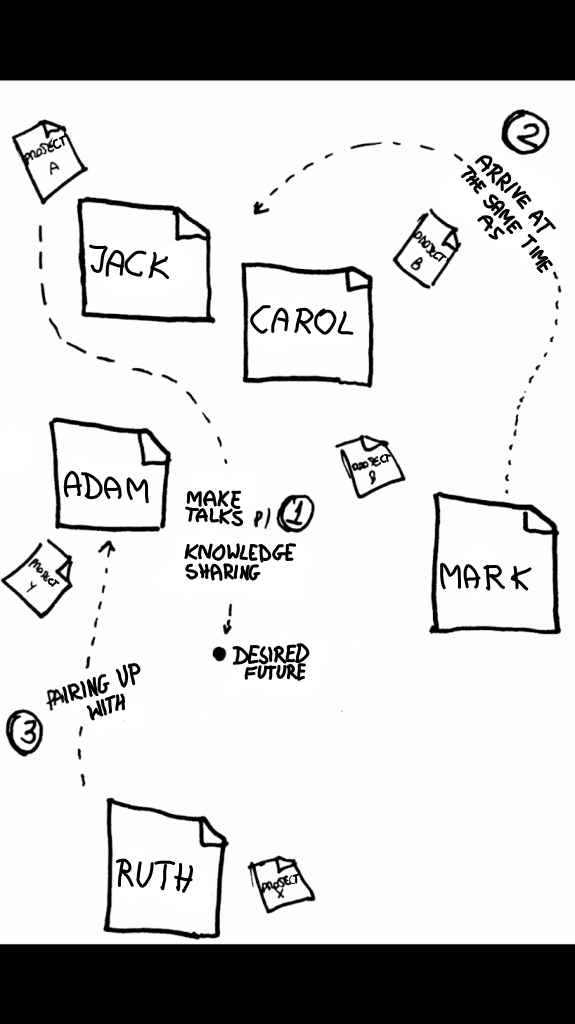This is a good retrospective for teams who are sick of retrospectives but also don’t like wildly different retrospectives.
Ever since Samuel Cavalcante (Agile Expert and Trainer at Knowledge21) and I started doing talks on Retro Poker, one of the most intriguing scenarios we usually present, as an example, is a team with four senior developers, one of which has recently joined the team, and an intern. The main challenge, apart from the clear isolation of the intern, is that the new developer will be a bit lost if the team isn’t open to doing retrospectives.
In such a scenario, it’s common to find ScrumMasters or Agile Coaches forcibly introducing activities using a fun, energizing tone of voice. They’re not realizing that any activity breaking the team’s usual sobriety is only going to awaken a feeling of “all right, can I get back to work now?”.
It was in this context that the “Tactical Scheme” retrospective, or “Tite’s Board”, emerged. And that’s a good hook into the first tip, which comes from a friend’s experience while working with this activity. If you present the retrospective as “Tite’s Board” (Tite is currently the Brazilian national team’s coach), don’t forget you’ll run the risk that the group may become limited to the tactical schemes in soccer, when this is in fact just an analogy. And all analogies tend to break at some point.
Step 1: Preparation
I usually get through this retrospective in under 30 minutes, with teams of up to ten people. All you need is a whiteboard and a marker pen. Large and small post-its are also useful here.
If this isn’t one of those “oh we do love retrospectives!” teams, it’s wise not to even say you’re going to do a retro. Just call their attention to the board for a 20-30 minute chat.
Step 2: Names
Ask each of them to place their name on the whiteboard, grouping the names of those who work together on a daily basis, and distancing those who have less contact.

It’s important that you as facilitator let each member write their own name. Don’t forget it’s their tactical formation, and not yours on their behalf. Facilitators who write a lot, rather than letting the team write, tend to generate less engagement.
In this step, the team’s current formation, hidden in the minds of each member, will be made explicit. The idea of “this needs improving” will probably start emerging.
This stage shouldn’t take more than five minutes.
Step 3: Tactical positioning
With the names placed on the board, ask each to write a project, product, system, activity or service (use the term best suited to the team’s context). Then position these on the board following the same premise as in the previous step. If you are familiar with this project (activity, system, etc.), place it near your name. If not, then place it further away and closer to whoever is involved.

At this stage, some of the risks of the team’s current formation generally start to become clear. For instance, one person is responsible for N critical projects, all of which are distant from other team members. The tendency in this step is to move towards the main provocation which this retrospective causes: are we really a team?
Step 4: Actions
The last stage consists of using the information made visually explicit on the board, to form actions to improve the tactical scheme. Ask the team to discuss and sketch on the board, movements which would be beneficial to the team: Ruth should work more with Adam on Project X, for example.

Prioritize these actions using Dot Voting and, if viable, ask those responsible to lead these themselves.
Real examples (and a bonus)
This retrospective isn’t only suited to teams who dislike such activities. I have real-life examples with teams who don’t work directly with software development. For example, I’ve used this with a startup team, right after the CEO’s strategic meeting. It was a team of about ten people responsible for the operation of the entire company. The results were very interesting indeed. Those who worked with prospecting for clients realized that they needed to move closer to customer service and operations.

A friend also used Tite’s Board to add the third step before listing actions, allowing for the team’s problem of silos to be revealed. He asked the team to place on the board not only projects but some of the people and areas outside the team (the testing or business areas, for example). It became clear how much closer to these areas the team was than other team members or projects. In fact, this is a classic symptom of companies which try to adopt the infamous “Spotify Model” and “squadify” everything in a top-down fashion. This retro is also a good way of starting a conversation about dysfunctions caused by this “squadifying” movement. But perhaps that should be a topic for another post. Haha.
If you’ve used “Tite’s Board”, please tell us how it went by commenting. If you adapted part of it, let me know: go on!
For other real application examples or to clarify any doubts, just drop me a line!
